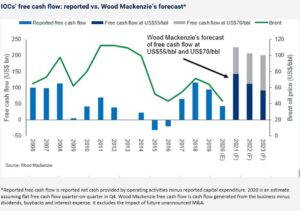IOCs emerge from “toughest year ever” primed for record free cash flow

International oil companies (IOCs) are primed for a V-shaped recovery in free cash flow and may generate record figures this year if oil prices average $55/bbl, according to a Wood Mackenzie analysis. Spot Brent is currently at $67/bbl.
“Savage cost cuts imposed last year as the global economy contracted in the face of the COVID-19 pandemic saw average IOC corporate cash flow breakevens reduced from $54/bbl pre-crisis to $38/bbl,” Tom Ellacott, Senior Vice President, Corporate Analysis, said.
“The record annual losses being announced in the Q4 earnings season serve as a stark reminder that 2020 was one of the toughest years in the industry’s history. But IOCs emerged from the crisis far more resilient to lower prices. The scale of their financial reset has primed the sector for a V-shaped recovery in free cash flow,” he said.
“At an average price of $55/bbl, our $140 billion estimate of 2021 free cash flow before shareholder distributions exceeds any previous year since 2006. Free cash flow generation would be double the previous peak if prices jumped to $70/bbl.”
“Our IOC peer group of 40 companies generates over $115 billion of surplus cash flow over the next three years after shareholder distributions, investment and interest at $55/bbl prices,” Mr Ellacott added. “At $70/bbl, cumulative surplus cash flow generation over the next three years would rocket to $400 billion.”
However, capital allocation priorities will be very different from any previous up-cycle.
Mending broken balance sheets will be at the top of the list. Average leverage – excluding operating leases – ballooned from 15% a decade ago to 35% by the end of 2019. The crisis of 2020 pushed it to 44% by Q3 2020, the highest this century.
Companies will aim to lower gearing to help weather future price volatility, either by cutting debt or growing equity – or both. Mr Ellacott said he believes most players would prefer to deleverage toward the low end of historical gearing ranges, which is about 20%.
“We expect companies to continue to plan for the worst, prioritizing net debt reduction in redeploying surplus cash flow,” he said. “Some players will also look to speed up debt reduction by selling non-core assets.”
Restoring investor confidence will be the second priority. Investment will recover only slowly even if confidence in higher prices grows. Strategic M&A will continue to favor paper over cash; share buybacks will be preferred over dividends for any surplus cash post-deleveraging.
“The sector is in ultra-capital-disciplined mode to win over investors,” Mr Ellacott said. “We think the industry will stick to its tight management of investment for some time.”
Concerns are growing that underinvestment may lead to a supply squeeze midterm. Indeed, the free cash flow generation Wood Mackenzie forecasts is in part a result of scaled-back spend.
Mr Ellacott said IOCs must also continue repositioning their portfolios for the energy transition. An elite group of financially strong operators can afford to be more strategic at current prices, allocating more capital to grow and decarbonize their legacy businesses or diversify into low-carbon energy. Others will follow as their balance sheets permit.
“Both M&A and organic-led growth in renewables will be on the strategic agenda. But disciplined screening criteria will have to apply to new energy investment too if oil and gas companies are to profitably diversify their product mix into low-carbon energy,” he said.
“Strategically, the move away from volume growth and towards harvesting the legacy oil and gas business is part of the energy transition reality – one in which pressure to decarbonize is only heading in one direction.”




